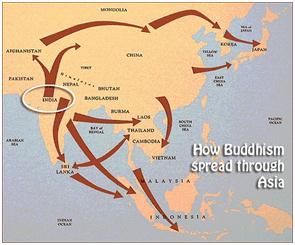‘The Ethics of AI: A Buddhist viewpoint’
-
Context
Today, Artificial Intelligence (AI) is the most discussed and arguably the most powerful technology in the world. The very rapid development of the technology calls for a systematic thinking about its ethical and social implications.
In this regard, the age-old tradition of Buddhist teaching offers a new perspective on how such a direction should take place.
-
Background
- The explosive growth of artificial intelligence has fostered hope that it will help solve many of the world’s most intractable problems.
- However, there’s also much concern about the power of AI, and growing agreement that its use should be guided to avoid infringing upon human rights.
- Many groups have discussed and proposed ethical guidelines for how AI should be developed or deployed.
- Unfortunately, most of these guidelines are developed by groups or organizations concentrated in North America and Europe.
- Guidelines reflect the values of the people who issue them. That most AI ethics guidelines are being written in Western countries means that the field is dominated by Western values such as respect for autonomy and the rights of individuals, especially since the few guidelines issued in other countries mostly reflect those in the West.
- However, for these guidelines to truly reflect the perspectives of people in non-Western countries, they would need to represent the traditional value systems found in each culture as well.
- Given this, insights derived from Buddhist teachingcould benefit anyone working on AI ethics anywhere in the world, and not only in traditionally Buddhist cultures (which are mostly in the East and primarily in Southeast Asia).
-
Analysis
Major ethical issues in AI
- Unemployment: As AI progresses, it is widely believed that it will steadily and inevitably take over large sectors of the workforce and will bring mass-scale unemployment and social unrest.
- Inequality: Rapid technological progress in artificial intelligence (AI) has been predicted to lead to rising inequality, and higher productivity growth through automation.
- Humanity: The technology is at the crossroads of either continuing to benefit society or turning to a path of harming it.
- Racist robots: Biased decision-making certainly isn't unique to AI systems, but in many ways, it is uniquely discoverable in these systems.
- Security issues: One of the major security risks to AI systems is the potential for adversaries to compromise the integrity of their decision-making processes so that they do not make choices in the manner that their designers would expect or desire
- Concerns regarding Robot rights: The legal standards pertaining to robots and quasi-intelligent algorithms probably are inadequate, however the more pressing issues pertain to legal not natural or human rights.
-
What Buddhism can do for AI ethics?
- Buddhism proposes a way of thinking about ethics based on the assumption that all sentient beings want to avoid pain.
- Thus, the Buddha teaches that an action is good if it leads to freedom from suffering.
- The implication of this teaching for artificial intelligence is that any ethical use of AI must strive to decrease pain and suffering.
- In other words, for example, facial recognition technology should be used only if it can be shown to reduce suffering or promote well-being.
- Moreover, the goal should be to reduce suffering for everyone—not just those who directly interact with AI.
Buddhism
- Buddhism was founded by the sage Siddhartha Gautama in 563-483 BCE.
- The word Buddha means ‘enlightened’, or the ‘one who is awake’.
Noble Truths
- The Four Noble Truths of Buddhism:
- suffering as a characteristic of existence
- the cause of suffering is craving and attachment
- the ceasing of suffering, called Nirvana
- the path to Nirvana, made up of eight steps, sometimes called the Eightfold Path
The Eightfold Path to Nirvana is to be "right" in all these areas: concentration, views, speech, resolve, action, livelihood, effort and mindfulness.
Types of Buddhism
There are three main types of Buddhism that represent specific geographical areas include:
- Theravada Buddhism: Prevalent in Thailand, Sri Lanka, Cambodia, Laos and Burma
- Mahayana Buddhism: Prevalent in China, Japan, Taiwan, Korea, Singapore and Vietnam
- Tibetan Buddhism: Prevalent in Tibet, Nepal, Mongolia, Bhutan, and parts of Russia and northern India
Spread of Buddhism
- 150 AD: Trade brings Indian people and beliefs to Asia, particularly China.3rd century: Teachings of Buddha are translated to Chinese.
- 3rd century: Ashoka the Great, the Mauryan Indian emperor, made Buddhism the state religion of India.
- 4th century: Introduced to Korea.
- 6th century: Introduced to Japan.
- 1100-1200: Muslims dominate India, and Buddhism becomes a very minor religion in the country.
- 1800s: Introduced to the United States, mostly on the west coast.
- 1959: Dalai Lama, the Buddhist leader in Tibet, flees to India to escape Chinese rule.
- Present - Buddhism remains a minor religion in its country of origin, India, with about eight million followers, or 0.7% of the total Indian population.


